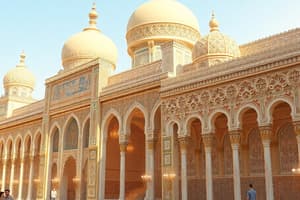Podcast
Questions and Answers
What is the main objective of the book mentioned in the text?
What is the main objective of the book mentioned in the text?
- To present a concise overview of contemporary museum architecture (correct)
- To showcase the evolution of museum architecture in the 20th century
- To explore the historical development of museums in Western society
- To highlight the role of museums in shaping modern nation-states
What has reaffirmed the power of the museum as a reference institution?
What has reaffirmed the power of the museum as a reference institution?
- The growth of private collecting
- The development of public collecting
- The continuous crises faced by museums (correct)
- The emergence of modern nation-states
What has the museum's development been closely tied to?
What has the museum's development been closely tied to?
- The expansion of modern societies
- The emergence of modern art and culture
- The growth of public and private collecting, as well as the definition of modern nation-states (correct)
- The evolution of Western culture
What is the role of the museum in shaping Western culture and art?
What is the role of the museum in shaping Western culture and art?
What has the museum institution been doing despite facing continuous crises?
What has the museum institution been doing despite facing continuous crises?
What is the idea of the museum key in defining?
What is the idea of the museum key in defining?
What is a key characteristic of museums conceived as organisms?
What is a key characteristic of museums conceived as organisms?
Which architect's design was influenced by Oriental architecture and evokes a sense of spirituality and connection to nature?
Which architect's design was influenced by Oriental architecture and evokes a sense of spirituality and connection to nature?
What is the name of the museum in New York designed by Frank Lloyd Wright?
What is the name of the museum in New York designed by Frank Lloyd Wright?
Which architect's design is characterized by flowing, curvilinear forms that evoke a sense of movement and energy?
Which architect's design is characterized by flowing, curvilinear forms that evoke a sense of movement and energy?
What is a characteristic of museums as sculptures?
What is a characteristic of museums as sculptures?
Who designed the Museu de Arte Contemporânea de Niterói in Rio de Janeiro, Brazil?
Who designed the Museu de Arte Contemporânea de Niterói in Rio de Janeiro, Brazil?
Flashcards are hidden until you start studying
Study Notes
Museums in the 21st Century
- The museum institution has expanded its crucial role in contemporary societies despite facing continuous crises since its foundation.
- The crises have reaffirmed the power of the museum as a reference institution and synthesis, capable of evolving and offering alternative models.
The Concept of Museum
- The idea of museum was key in defining the concepts of culture and art in Western society.
- The museum's role in shaping Western culture and art is undeniable.
- Its development has been closely tied to the emergence of public and private collecting, as well as the definition of modern nation-states.
Museum Architecture
- The modern concept of museum architecture emerged in the 1930s and 1940s.
- Architects like Frank Lloyd Wright, Mies van der Rohe, Le Corbusier, and Marcel Duchamp proposed innovative designs that challenged traditional museum structures.
- Examples of architects and their works include:
- Frank Lloyd Wright: Guggenheim Museum, New York (1943-1959)
- Mies van der Rohe: Museum for a Small Town (1942)
- Le Corbusier: Museum of Unlimited Growth (1939)
- Marcel Duchamp: The Large Glass (1915-1923)
The Museum as an Organism
- The museum can be conceived as a singular organism, a unique event, or an exceptional happening.
- This concept is often applied in urban contexts, where the building stands out as a radical counterpoint, aiming to create a shock effect.
- Examples of museums that embody this concept include:
- The Guggenheim Museum, designed by Frank Lloyd Wright, which responds to the city's prismatic and stepped skyscrapers.
- Pavilion of Japanese Art, designed by Bruce Goff, which features forms inspired by Oriental architecture.
Museums as Sculptures
- The concept of museums as sculptures dates back to the early 20th century, when architects like Frank Lloyd Wright and Bruce Goff began experimenting with organic and expressive forms.
- Examples of museums as sculptures include:
- Museu Guggenheim Bilbao, Spain (1991-1997), designed by Frank Gehry, featuring flowing, curvilinear forms.
- Museu Vitra, Weil am Rhein, Germany (1987-1989), designed by Frank Gehry, featuring three interconnected spaces with fluid, organic forms.
- Museu de Arte Contemporânea de Niterói, Rio de Janeiro, Brazil (1990-1996), designed by Oscar Niemeyer, featuring a dynamic, sculptural form reminiscent of a spaceship.
- Characteristics of museums as sculptures include:
- Organic forms that evoke a sense of movement and energy.
- Expressive materials that add to the building's sculptural quality.
- Dynamic spaces that are designed to be flexible and adaptable.
Studying That Suits You
Use AI to generate personalized quizzes and flashcards to suit your learning preferences.




